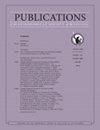来自盖亚的宽后共同包络双星:轨道验证和形成模型
IF 7.7
3区 物理与天体物理
Q2 ASTRONOMY & ASTROPHYSICS
Publications of the Astronomical Society of the Pacific
Pub Date : 2024-08-12
DOI:10.1088/1538-3873/ad6809
引用次数: 0
摘要
盖亚DR3的天体测量发现了3000多个双星样本,其中包含白矮星(WD)和主序星(MS),它们的轨道相对较宽,轨道周期Porb = (100-1000)天。在盖亚之前,双星种群合成模型并没有预测到这一种群,如果盖亚轨道是稳健的--很可能需要在共同包层演化(CEE)过程中进行非常有效的包层抛射。为了评估 Gaia 解决方案的可靠性,我们测量了 31 个 Porb = (40-300) 天的 WD+MS 双星候选体的多波段径向速度(RV)和 AstroSpectroSB1 轨道解决方案。我们联合拟合了 RV 和天体测量,从而验证了 Gaia 解决方案,并加强了对成分质量的约束。我们发现 Gaia 解决方案的成功率很高,31 个系统中只有 2 个系统的 Gaia 轨道解决方案与我们的 RV 存在显著差异。我们发现大多数天体的通量比 S≲0.02,这证实了伴星确实是 WD。我们加强了对双星偏心率的约束,发现中位数 e≈ 0.1。这些偏心率比类似周期的正常MS+MS双星的偏心率要低得多,但比通过稳定质量转移形成的双星的预测偏心率要高得多。我们提出了MESA单星和双星演化模型,以探索双星可能是如何形成的。样本中大多数双星的轨道都是在WD原生星是一颗AGB恒星时通过CEE产生的,对应于2-5 au的初始分离。据预测,在所有后共包层双星中,大约有 50%的双星首先在 AGB 恒星上发生相互作用,最终形成像这些系统一样的宽轨道。本文章由计算机程序翻译,如有差异,请以英文原文为准。
Wide Post-common Envelope Binaries from Gaia: Orbit Validation and Formation Models
Astrometry from Gaia DR3 has enabled the discovery of a sample of 3000+ binaries containing white dwarfs (WD) and main-sequence (MS) stars in relatively wide orbits, with orbital periods P
orb = (100–1000) days. This population was not predicted by binary population synthesis models before Gaia and—if the Gaia orbits are robust—likely requires very efficient envelope ejection during common envelope evolution (CEE). To assess the reliability of the Gaia solutions, we measured multi-epoch radial velocities (RVs) of 31 WD+MS binary candidates with P
orb = (40–300) days and AstroSpectroSB1 orbital solutions. We jointly fit the RVs and astrometry, allowing us to validate the Gaia solutions and tighten constraints on component masses. We find a high success rate for the Gaia solutions, with only 2 out of the 31 systems showing significant discrepancies between their Gaia orbital solutions and our RVs. Joint fitting of RVs and astrometry allows us to directly constrain the secondary-to-primary flux ratio
S , and we find
S ≲ 0.02 for most objects, confirming the companions are indeed WDs. We tighten constraints on the binaries’ eccentricities, finding a median e ≈ 0.1. These eccentricities are much lower than those of normal MS+MS binaries at similar periods, but much higher than predicted for binaries formed via stable mass transfer. We present MESA single and binary evolution models to explore how the binaries may have formed. The orbits of most binaries in the sample can be produced through CEE that begins when the WD progenitor is an AGB star, corresponding to initial separations of 2–5 au. Roughly 50% of all post-common envelope binaries are predicted to have first interacted on the AGB, ending up in wide orbits like these systems.
求助全文
通过发布文献求助,成功后即可免费获取论文全文。
去求助
来源期刊
CiteScore
6.70
自引率
5.70%
发文量
103
审稿时长
4-8 weeks
期刊介绍:
The Publications of the Astronomical Society of the Pacific (PASP), the technical journal of the Astronomical Society of the Pacific (ASP), has been published regularly since 1889, and is an integral part of the ASP''s mission to advance the science of astronomy and disseminate astronomical information. The journal provides an outlet for astronomical results of a scientific nature and serves to keep readers in touch with current astronomical research. It contains refereed research and instrumentation articles, invited and contributed reviews, tutorials, and dissertation summaries.

 求助内容:
求助内容: 应助结果提醒方式:
应助结果提醒方式:


